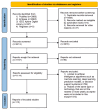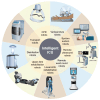Advances in the Application of AI Robots in Critical Care: Scoping Review
- PMID: 38801765
- PMCID: PMC11165292
- DOI: 10.2196/54095
Advances in the Application of AI Robots in Critical Care: Scoping Review
Abstract
Background: In recent epochs, the field of critical medicine has experienced significant advancements due to the integration of artificial intelligence (AI). Specifically, AI robots have evolved from theoretical concepts to being actively implemented in clinical trials and applications. The intensive care unit (ICU), known for its reliance on a vast amount of medical information, presents a promising avenue for the deployment of robotic AI, anticipated to bring substantial improvements to patient care.
Objective: This review aims to comprehensively summarize the current state of AI robots in the field of critical care by searching for previous studies, developments, and applications of AI robots related to ICU wards. In addition, it seeks to address the ethical challenges arising from their use, including concerns related to safety, patient privacy, responsibility delineation, and cost-benefit analysis.
Methods: Following the scoping review framework proposed by Arksey and O'Malley and the PRISMA (Preferred Reporting Items for Systematic Reviews and Meta-Analyses) guidelines, we conducted a scoping review to delineate the breadth of research in this field of AI robots in ICU and reported the findings. The literature search was carried out on May 1, 2023, across 3 databases: PubMed, Embase, and the IEEE Xplore Digital Library. Eligible publications were initially screened based on their titles and abstracts. Publications that passed the preliminary screening underwent a comprehensive review. Various research characteristics were extracted, summarized, and analyzed from the final publications.
Results: Of the 5908 publications screened, 77 (1.3%) underwent a full review. These studies collectively spanned 21 ICU robotics projects, encompassing their system development and testing, clinical trials, and approval processes. Upon an expert-reviewed classification framework, these were categorized into 5 main types: therapeutic assistance robots, nursing assistance robots, rehabilitation assistance robots, telepresence robots, and logistics and disinfection robots. Most of these are already widely deployed and commercialized in ICUs, although a select few remain under testing. All robotic systems and tools are engineered to deliver more personalized, convenient, and intelligent medical services to patients in the ICU, concurrently aiming to reduce the substantial workload on ICU medical staff and promote therapeutic and care procedures. This review further explored the prevailing challenges, particularly focusing on ethical and safety concerns, proposing viable solutions or methodologies, and illustrating the prospective capabilities and potential of AI-driven robotic technologies in the ICU environment. Ultimately, we foresee a pivotal role for robots in a future scenario of a fully automated continuum from admission to discharge within the ICU.
Conclusions: This review highlights the potential of AI robots to transform ICU care by improving patient treatment, support, and rehabilitation processes. However, it also recognizes the ethical complexities and operational challenges that come with their implementation, offering possible solutions for future development and optimization.
Keywords: AI; ICU; artificial intelligence; critical care medicine; intensive care unit; robotics.
©Yun Li, Min Wang, Lu Wang, Yuan Cao, Yuyan Liu, Yan Zhao, Rui Yuan, Mengmeng Yang, Siqian Lu, Zhichao Sun, Feihu Zhou, Zhirong Qian, Hongjun Kang. Originally published in the Journal of Medical Internet Research (https://www.jmir.org), 27.05.2024.
Conflict of interest statement
Conflicts of Interest: None declared.
Figures
Similar articles
-
Artificial intelligence for breast cancer detection and its health technology assessment: A scoping review.Comput Biol Med. 2025 Jan;184:109391. doi: 10.1016/j.compbiomed.2024.109391. Epub 2024 Nov 22. Comput Biol Med. 2025. PMID: 39579663
-
The Increasing Centrality of Robotic Technology in the Context of Nursing Care: Bioethical Implications Analyzed through a Scoping Review Approach.J Healthc Eng. 2021 Aug 28;2021:1478025. doi: 10.1155/2021/1478025. eCollection 2021. J Healthc Eng. 2021. PMID: 34493953 Free PMC article.
-
Application of Artificial Intelligence in Community-Based Primary Health Care: Systematic Scoping Review and Critical Appraisal.J Med Internet Res. 2021 Sep 3;23(9):e29839. doi: 10.2196/29839. J Med Internet Res. 2021. PMID: 34477556 Free PMC article.
-
Mapping and Summarizing the Research on AI Systems for Automating Medical History Taking and Triage: Scoping Review.J Med Internet Res. 2025 Feb 6;27:e53741. doi: 10.2196/53741. J Med Internet Res. 2025. PMID: 39913918 Free PMC article.
-
Robots in Assisted Living Facilities: Scoping Review.JMIR Aging. 2023 Mar 6;6:e42652. doi: 10.2196/42652. JMIR Aging. 2023. PMID: 36877560 Free PMC article.
Cited by
-
BART, the new robotic assistant: big data, artificial intelligence, robotics, and telemedicine integration for an ICU 4.0.J Anesth Analg Crit Care. 2024 Jul 12;4(1):44. doi: 10.1186/s44158-024-00180-4. J Anesth Analg Crit Care. 2024. PMID: 38992794 Free PMC article.
-
Knowledge and attitudes toward artificial intelligence in nursing among various categories of professionals in China: a cross-sectional study.Front Public Health. 2024 Jul 2;12:1433252. doi: 10.3389/fpubh.2024.1433252. eCollection 2024. Front Public Health. 2024. PMID: 39015390 Free PMC article.
-
Evaluation of nurses' perspectives on the design and use of assistant nurse robots in obstetrics and neonatal care: a mixed-method study.BMC Nurs. 2025 Apr 1;24(1):359. doi: 10.1186/s12912-025-03025-9. BMC Nurs. 2025. PMID: 40170129 Free PMC article.
-
Emerging technologies in airway management: a narrative review of intubation robotics and anatomical structure recognition algorithms.Biomed Eng Online. 2025 Jun 24;24(1):77. doi: 10.1186/s12938-025-01408-2. Biomed Eng Online. 2025. PMID: 40551095 Free PMC article. Review.
References
-
- McKendrick M, Yang S, McLeod GA. The use of artificial intelligence and robotics in regional anaesthesia. Anaesthesia. 2021 Jan;76 Suppl 1:171–81. doi: 10.1111/anae.15274. https://onlinelibrary.wiley.com/doi/10.1111/anae.15274 - DOI - DOI - PubMed
-
- Javaid M, Haleem A, Vaishya R, Bahl S, Suman R, Vaish A. Industry 4.0 technologies and their applications in fighting COVID-19 pandemic. Diabetes Metab Syndr. 2020;14(4):419–22. doi: 10.1016/j.dsx.2020.04.032. https://europepmc.org/abstract/MED/32344370 S1871-4021(20)30094-1 - DOI - PMC - PubMed
Publication types
MeSH terms
LinkOut - more resources
Full Text Sources
Medical



